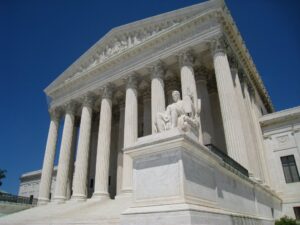Unless you are well into middle age or were a precocious student, you probably have little memory of the United States without the Environmental Protection Agency and the host of federal statutes it implements. You may not be aware of the long history of environmental controls through common-law protections. (Common law is the term we use for the legal rules and traditions that have been developed over time through court decisions.)
In the past, people who allowed something noxious to escape their control and invade the property of others could be held accountable through legal actions for trespass and nuisance. This protection was extended to water quality through riparian rights, which allow water users the right to the use and enjoyment of water. The following cases illustrate common-law protection of surface water, groundwater, and air.
In the late nineteenth century, the Carmichael family owned a 45-acre farm in Texas, with a stream running through it, that bordered on the state of Arkansas. The city of Texarkana, Arkansas, built a sewage system and connected numerous residences and businesses to it. The sewage collected by the city system was deposited in front of the Carmichaels’ homestead, about eight feet from the state line, on the Arkansas side.1 The Carmichaels sued the city in federal court in Arkansas.
The court found that the cesspool was a “great nuisance” that polluted the stream on the Carmichaels’ property, “depositing the foul and offensive matter . . . in the bed of said creek on plaintiffs’ land and homestead continuously. . . .” The court said that this cesspool deprived the family of the “use and benefit of said creek running through their land and premises in a pure and natural state as it was before the creation of said cesspool. . . .”(2)
The claims for damages were awarded, as was the plaintiffs’ suit for an injunction against the cesspool. The court cited a leading text on the law of torts:
If a riparian proprietor has a right to enjoy a river so far unpolluted that fish can live in it and cattle drink of it and the town council of a neighboring borough, professing to act under statutory powers, pour their house drainage and the filth from water-closets into the river in such quantities that the water becomes corrupt and stinks, and fish will no longer live in it, nor cattle drink it, the court will grant an injunction to prevent the continued defilement of the stream, and to relieve the riparian proprietor from the necessity of bringing a series of actions for the daily annoyance. In deciding the right of a single proprietor to an injunction, the court cannot take into consideration the circumstance that a vast population will suffer by reason of its interference.3
Judge Rogers noted: “I have failed to find a single well-considered case where the American courts have not granted relief under circumstances such as are alleged in this bill against the city. . . .”(4)
So, long before the Environmental Protection Agency came into existence, municipalities and firms knew that if they substantially polluted their neighbors’ water, they could expect to be found liable. To minimize liability, water polluters installed pollution control devices. Paper mills in Wisconsin routinely owned miles of downstream river property, knowing that otherwise they would be liable for violation of riparian rights (Davis 1971, 777Ð80).
Such common-law protection of water applies to all who have the right to use the water, for purposes including recreation. Those who enjoy sport fishing in England have long protected water quality through private litigation brought by angling associations.
The primary problem caused by pollution of land is groundwater pollution due to seepage from improperly disposed of wastes. Wastes that are properly contained rarely cause harm. After Congress passed the Superfund law in 1980 (the Comprehensive Environmental Response Compensation and Liability Act) to regulate the cleanup of toxic waste sites, relatively few common-law cases have occurred. However, they show how the common law might have dealt with the problem of groundwater pollution over time.(5)
For example, in 1981, the Illinois EPA, backed by the federal EPA, supported the right of a chemical waste landfill to remain in operation. The landfill had been built with state and federal approval, but residents of a nearby village alleged that the landfill was damaging their water supply.
The Illinois supreme court agreed.6 It held that the landfill was a public and a private nuisance. The village residents were there first; their right not to have their property damaged could not be stripped in favor of a “general societal” desire for a landfill. In other words, toxic landfills are legitimate, but they must constructed so as not to impose costs on surrounding landowners who have not agreed to the intrusion. The court issued a permanent injunction against the landfill and ordered that the toxic wastes be dug up, moved, and the land restored.
The courts’ view of the standards for groundwater contamination has evolved over the decades, as the 1982 case of Wood v. Picillo7 illustrates. Neighboring property owners sued a farmer who maintained a hazardous waste dump on his property. They claimed that the dump emitted noxious fumes and polluted groundwater. The Rhode Island supreme court agreed. In doing so it overturned a 1934 decision that would have supported the defendant’s position. The 1934 decision was based on the state of science at that time, when knowledge about the course of groundwater was, as the court stated in 1982, “indefinite and obscure.” Since 1934, the court said:
the science of groundwater hydrology as well as societal concern for environmental protection has developed dramatically. As a matter of scientific fact the courses of subterranean waters are no longer obscure and mysterious. . . . We now hold that negligence is not a necessary element of a nuisance case involving contamination of public or private waters by pollutants percolating through the soil and traveling underground routes.(8)
This means that the common law now imposes strict liability (that is, liability even when there is no negligence) on polluters who cause damage to waters. standard of care is consistent with old commonlaw tort rules imposing strict liability in case of hazardous materials, rules recorded in a famous 1868 British case, Rylands v. Fletcher.9 This case is often cited for restating the ancient proposition, “So use your property as not to injure your neighbor’s property.”
The courts have long recognized common-law liability for air pollution when liability can be assigned to a polluter causing harm. An early case was Georgia v. Tennessee Copper Co.(10)
The state of Georgia, on behalf of its citizens, sued two companies that operated copper smelters in Tennessee near the Georgia border. Justice Holmes noted that a public nuisance had been created because the “sulphurous fumes cause and threaten damage on so considerable a scale to the forests and vegetable life, if not to health, within [several counties in Georgia]. . . .”11 Defendants argued that they had recently constructed new facilities that reduced the scope of the problem, but the Supreme Court held for Georgia. The Court gave the companies a reasonable time to build more emissioncontrol equipment, but held that if such equipment did not reduce emissions enough to protect plant life in Georgia, the state could ask the court for an injunction to shut down the smelters.
In 1915 the parties returned to the Supreme Court.12 The companies showed that their new, expensive equipment cut emissions by more than half. Georgia argued that this was not enough and demanded that the smelters be closed. The chief justice appointed a scientist from Vanderbilt University to spend six months, at company expense, studying the emissions and the likely effect of new controls. In the meantime, the Court ordered the companies to cut back production to reduce emissions further. Based on the evidence presented by the scientist, the companies would either be allowed to continue operation with more emission-control equipment in place, or, if that could not reduce emissions sufficiently, would have to shut down. Finally, after following the guidance of the Vanderbilt professor, the firm satisfied the plaintiffs, and the Court ended its oversight of the case.
The common-law approach was not perfect. The cases reported here represent the majority view, but there was a minority view, also. Some courts would rule for polluters, holding that the economic benefit of a factory that employed many people outweighed the damage to a few property holders. Some courts held that pollution was just a fact of modern life and necessary for progress to occur. The courts were not always consistent in their decisions.
There were other problems. For one, legal action is always costly. Second, multiple polluters that each inflict low levels of damage are unlikely to be held liable -especially when the damage is shared by many. For that reason, problems with air pollution caused by automobiles cannot be handled effectively through common-law courts.
Injuries and harms that come after long gestation periods present another challenge. While parties who can show evidence of injury or imminent harm may have a common-law cause of action, efforts to obtain injunctions for speculative harms such as future cancer are not generally successful.
However, we cannot know how the law might have evolved had it not been pushed to one side by regulation. Environmental courts-ordinary courts assisted by special masters trained in environmental science-and other arrangements might well have evolved to satisfy the needs of people concerned about their environmental rights.
In our view, it is time to consider a return to the regime that served us well in the past and that has shown signs of evolving as knowledge and environmental concerns changed. The common law provides harsh penalties against firms that disregard the rights of citizens by exposing them to harms. Indeed, when real harm is inflicted, citizens get far better relief through common-law suits than they do from appeals to the Environmental Protection Agency. Eventually, we believe that citizens will recognize that the common law, bolstered by local regulation, can protect the environment more effectively and fairly than can congressional statutes and bureaucratic regulations.
Notes
1. Carmichael v. City of Texarkana, 94 F. 561 (W.D. Ark., 1899).
2. 94 F.Supp. 561 at 562.
3. 94 F.Supp. 561 at 573.
4. 94 F.Supp. 561 at 574.
5. The story of Love Canal, the incident that led to the passage of Superfund, is poorly understood. Ultimately, the people of Love Canal were protected through a common-law suit. A more detailed discussion can be found in the longer PERC Policy Series (PS-13) from which this is excerpted.
6. Village of Wilsonville v. SCA Services, 426 N.E.2d 824 (1981).
7. 443 A.2d 1244 (1982).
8. 443 A.2d 1244 at 1249.
9. L.R. 3 H.L. 330 (1868).
10. 27 S.Ct. 618 (1907).
11. 27 S.Ct. 618 at 620.
12. Georgia v. Tennessee Copper Co., 237 U.S. 474 (1915); 237 U.S. 678 (1915); and 240 U.S. 650 (1916).





